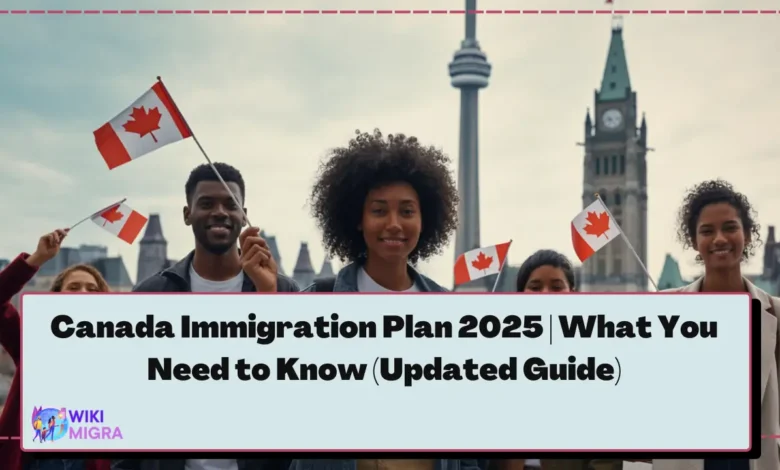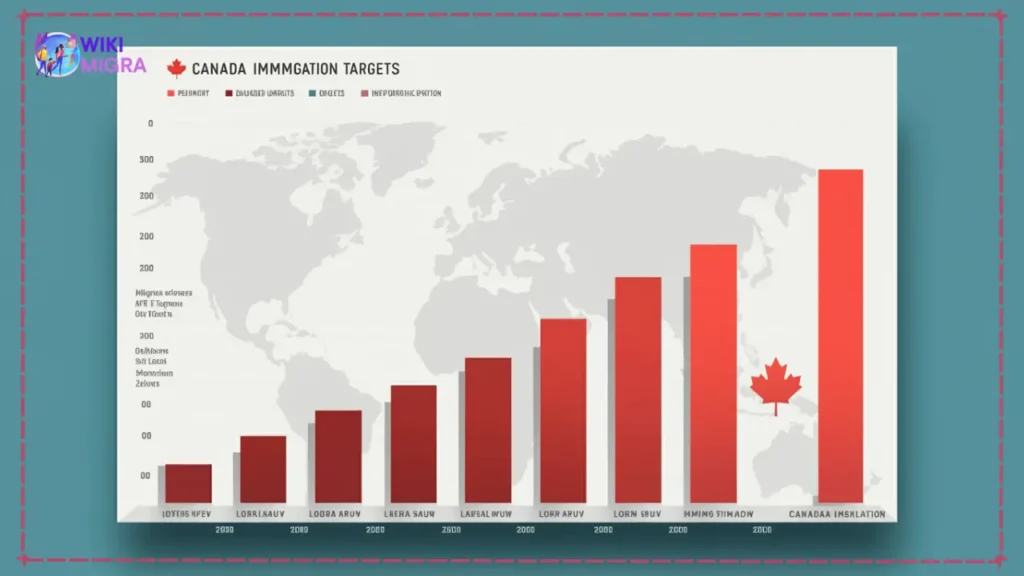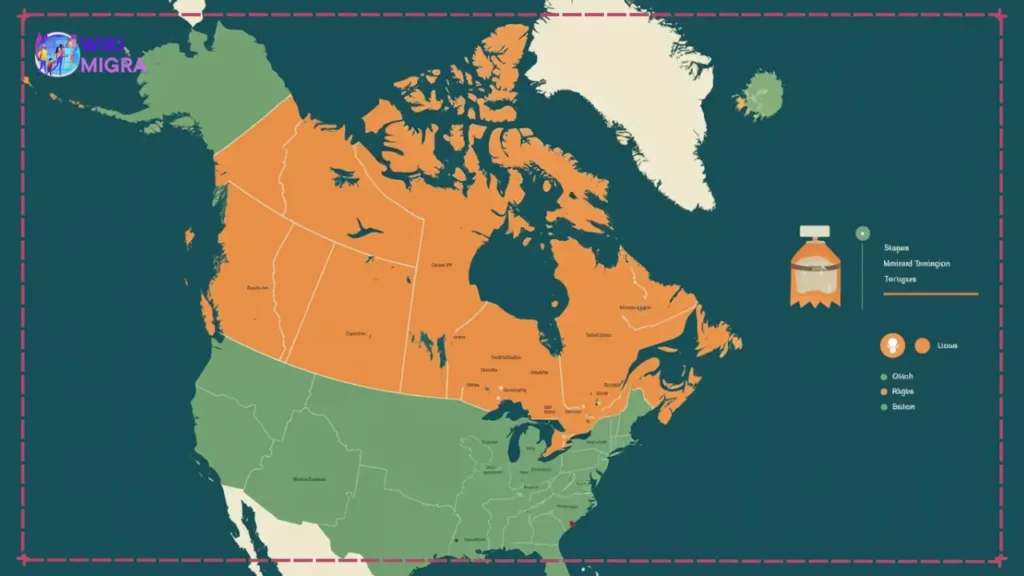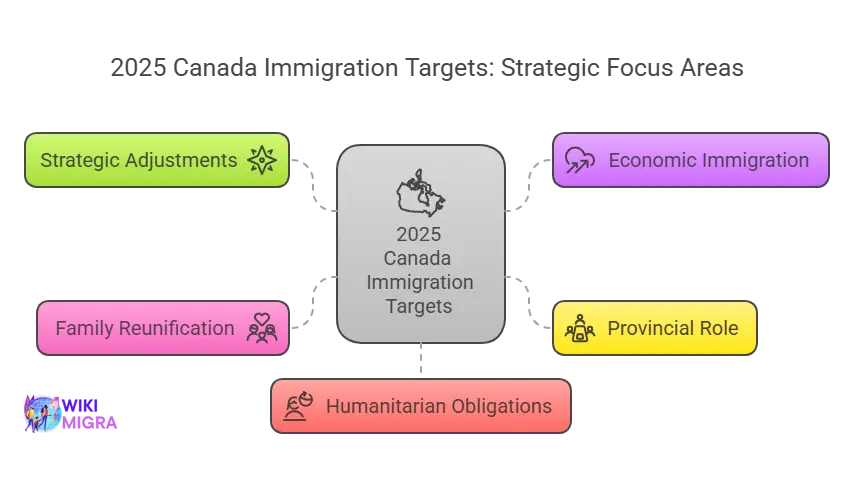Canada Immigration Plan 2025 | What You Need to Know (Updated Guide)

Canada’s Immigration Plan 2025-2027 represents the government’s strategic framework for welcoming newcomers over the next three years. This latest iteration showcases Canada’s commitment to economic growth, family reunification, and humanitarian obligations through carefully planned immigration targets. With significant adjustments to various immigration streams, the 2025 plan introduces several important changes that potential immigrants need to understand.

The Canada Immigration Plan 2025 continues the country’s trajectory of increasing immigration levels, though with some strategic adjustments compared to previous years. Whether you’re considering Express Entry, Provincial Nomination, or Family Sponsorship pathways, understanding these changes is critical to planning your immigration journey successfully.
This comprehensive guide aims to provide you with actionable insights into the Canada Immigration Levels 2025, helping you navigate the evolving immigration landscape with confidence and clarity.
You may be interested in: Your Guide to Express Entry Canada in 2025
Overview of the 2025-2027 Immigration Levels Plan

The Canada Immigration Plan 2025-2027 sets ambitious targets for welcoming newcomers over the next three years. The government has established the following overall immigration targets:
- 2025: 485,000 permanent residents
- 2026: 500,000 permanent residents
- 2027: 500,000 permanent residents
Breakdown by Immigration Category
The 2025 Canada Immigration Targets are distributed across three main categories:
Economic Class (approximately 60% of total):
- Express Entry programs: 110,000
- Provincial Nominee Programs: 105,000
- Atlantic Immigration Program: 8,500
- Rural and Northern Immigration Pilot: 2,750
- Economic Pilots and other economic programs: 65,750
Family Class (approximately 25% of total):
- Spouses, Partners, and Children: 78,000
- Parents and Grandparents: 32,000
Refugee and Humanitarian Class (approximately 15% of total):
- Resettled Refugees: 28,500
- Protected Persons in Canada and Dependents: 24,500
- Humanitarian and Compassionate Cases: 10,000
Comparison to Previous Years
The 2025 Canada Immigration Targets represent a strategic adjustment from previous years:
- 2022: 405,000 (actual admissions)
- 2023: 465,000 (target)
- 2024: 485,000 (target)
- 2025: 485,000 (target)
- 2026: 500,000 (target)
- 2027: 500,000 (target)
This pattern shows a stabilization of immigration targets after several years of significant increases. While the overall numbers remain high, the 2025-2027 plan demonstrates a more measured approach, focusing on quality and integration capacity rather than continuously increasing quantity.
Impact on Key Immigration Streams

1. Express Entry
The Canada Immigration Plan 2025 introduces notable changes to the Express Entry system, which manages applications for the Federal Skilled Worker Program, Canadian Experience Class, and Federal Skilled Trades Program.
Predicted Changes to CRS Scores
With the continued high targets for Express Entry programs in the Canada Immigration Levels 2025, we can expect Comprehensive Ranking System (CRS) score thresholds to remain competitive. Based on recent trends:
- The general CRS cutoff is predicted to fluctuate between 470-490 points for all-program draws
- Program-specific draws will likely continue, with lower thresholds for targeted occupations
- Category-based selection will be expanded to focus on specific in-demand sectors
Impact on Specific Express Entry Programs
Federal Skilled Worker Program (FSW):
- Increased allocations for candidates with expertise in healthcare, technology, and construction
- Enhanced emphasis on Canadian educational credentials and prior work experience
- Priority processing for occupations facing critical labor shortages
Canadian Experience Class (CEC):
- Maintained strong pathway for temporary residents transitioning to permanent residence
- Potential lowering of work experience requirements in certain sectors
- Expanded eligibility for non-LMIA work permit holders
Federal Skilled Trades Program (FST):
- Increased quotas for trades facing national shortages
- Simplified language requirements for certain trades
- Potential introduction of pre-arrival skills verification programs
Strategies to Improve Chances of Selection
To maximize your chances under the 2025 Canada Immigration Targets:
- Enhance language proficiency: Aim for CLB 9 or higher in English and/or French
- Pursue Canadian education: Even a one-year post-graduate program can significantly boost CRS scores
- Gain skilled work experience: Focus on in-demand occupations, particularly those targeted by category-based selections
- Obtain provincial nomination: A provincial nomination adds 600 points to your CRS score
- Consider a job offer: LMIA-backed job offers provide substantial CRS points
- Update your profile regularly: Ensure all qualifications and achievements are reflected accurately
2. Provincial Nominee Programs (PNPs)
The 2025 Canada Immigration Plan allocates approximately 105,000 spots to Provincial Nominee Programs, recognizing their critical role in addressing regional labor market needs.
Changes to PNP Allocations and Priorities
- Increased nomination quotas: Many provinces will see higher allocation numbers
- Targeted occupation lists: More specific and frequently updated in-demand occupation lists
- Regional distribution focus: Enhanced quotas for smaller provinces and territories
- Express Entry alignment: Continued integration with federal Express Entry system
- Entrepreneurial streams: Expanded pathways for business owners and investors
PNPs with High Potential for Specific Skills/Professions
Ontario Immigrant Nominee Program (OINP):
- Priority sectors: Technology, healthcare, skilled trades, manufacturing
- Enhanced focus on foreign workers already in Ontario
- Targeted draws for specific tech occupations
British Columbia Provincial Nominee Program (BC PNP):
- Healthcare, technology, and childcare sectors prioritized
- Regional pilot programs for smaller communities
- Entrepreneurial immigration opportunities with lower investment thresholds
Alberta Advantage Immigration Program (AAIP):
- Focus on healthcare, technology, agriculture, and energy sectors
- Accelerated pathway for temporary residents already working in Alberta
- Rural Renewal Stream opportunities
Manitoba Provincial Nominee Program (MPNP):
- In-demand occupations in manufacturing, agriculture, and healthcare
- Community support pathways for smaller towns
- Business investor opportunities with lower capital requirements
Saskatchewan Immigrant Nominee Program (SINP):
- Agriculture, manufacturing, mining, and healthcare focus
- Entrepreneur pathways with business establishment support
- Enhanced points for applicants willing to settle in smaller communities
3. Family Sponsorship
The 2025 Canada Immigration Levels Plan allocates approximately 110,000 spots for family sponsorship programs, demonstrating Canada’s continued commitment to family reunification.
Potential Changes to Processing Times
Under the Canada Immigration Plan 2025:
- Spousal sponsorship processing targets: 80% of applications processed within 12 months
- Parents and Grandparents Program: Expected lottery system with increased quota of 32,000
- Dependent children: Priority processing with 80% completed within 6 months
- Digital application processing: Enhanced online systems to reduce processing delays
Eligibility Requirements and Updates
Spousal Sponsorship:
- Maintained income requirements adjusted for inflation
- Enhanced background verification processes
- Simplified documentation requirements for certain nationalities
- Extended open work permits for in-Canada spousal applicants
Parents and Grandparents Program:
- Continued lottery-based system with increased quotas
- Multi-year income verification for sponsors
- Extended Super Visa duration options
- Alternative pathways for parents with specific skills
4. Other Streams
Atlantic Immigration Program (AIP)
The Canada Immigration Plan 2025 allocates 8,500 spots to the Atlantic Immigration Program, recognizing its success in attracting and retaining immigrants to Atlantic provinces.
- Expansion of eligible employers: Broader participation across various sectors
- Streamlined settlement requirements: Enhanced pre-arrival services
- Expedited processing: Typically 6 months or less for complete applications
- Potential pathway adjustments: Lower experience requirements for certain occupations
Rural and Northern Immigration Pilot (RNIP)
With 2,750 spots allocated in the 2025 Canada Immigration Targets, the RNIP continues to support smaller communities:
- Community expansion: More participating communities added to the program
- Simplified community endorsement: Streamlined local approval processes
- Integration with other programs: Enhanced pathways to permanent residence
- Sector-specific focus: Targeted recruitment for healthcare, education, and essential services
You may be interested in: CRS Tool Canada | Your Key to Navigating Immigration
Geographic Considerations

Provincial Needs and In-Demand Occupations
The Canada Immigration Plan 2025 reflects diverse provincial labor market needs:
Ontario:
- Technology (software developers, cybersecurity specialists, AI researchers)
- Healthcare (nurses, physicians, personal support workers)
- Skilled trades (electricians, plumbers, carpenters)
- Finance (financial analysts, accountants, investment specialists)
British Columbia:
- Technology (web developers, UX/UI designers, data scientists)
- Healthcare (medical technicians, nurses, care aides)
- Construction (project managers, engineers, skilled tradespeople)
- Film and animation (digital artists, production specialists)
Alberta:
- Energy sector (petroleum engineers, geologists, renewable energy specialists)
- Healthcare (rural physicians, specialists, nurses)
- Agriculture (farm managers, agricultural technologists)
- Technology (software engineers, systems analysts)
Quebec:
- Technology (artificial intelligence specialists, game developers)
- Healthcare (all medical professionals, especially bilingual)
- Manufacturing (process engineers, skilled operators)
- Aerospace (engineers, technicians, designers)
Atlantic Provinces:
- Healthcare (all positions, especially rural practitioners)
- Tourism and hospitality (management positions)
- Seafood processing (technicians, quality control)
- Information technology (developers, network administrators)
Prairies (Saskatchewan and Manitoba):
- Agriculture (farm managers, technicians, researchers)
- Manufacturing (production supervisors, quality control)
- Healthcare (all positions, particularly in rural areas)
- Transportation (truck drivers, logistics specialists)
Territories (Yukon, Northwest Territories, Nunavut):
- Mining (engineers, heavy equipment operators)
- Healthcare (all positions, with northern experience preferred)
- Education (teachers, administrators)
- Public administration (program officers, analysts)
Actionable Advice for Potential Immigrants
Assess Eligibility and Explore Immigration Options
- Use official assessment tools:
- Create an Express Entry profile and see your CRS score
- Check provincial eligibility through official PNP websites
- Use the Come to Canada Wizard on the IRCC website
- Identify your best pathway:
- Express Entry (for skilled workers with language proficiency)
- Provincial Nomination (for those matching specific provincial needs)
- Family Sponsorship (for those with eligible Canadian relatives)
- Study-to-PR pathway (for those considering Canadian education first)
- Consider multiple options simultaneously:
- Apply to Express Entry and PNP streams
- Explore both economic and family class options if applicable
- Consider temporary pathways leading to permanent residence
Gather Required Documents and Prepare Applications
- Essential documentation for most programs:
- Valid passport (with at least two years validity remaining)
- Language test results (IELTS, CELPIP, or TEF)
- Educational Credential Assessment (ECA)
- Proof of funds (for most economic class applications)
- Police clearance certificates
- Medical examination results
- Application preparation strategies:
- Create a document checklist specific to your chosen program
- Begin gathering documents early (some may take months to obtain)
- Translate documents professionally if not in English or French
- Keep digital and physical copies of all documents
- Ensure consistency across all application materials
- Timeline planning:
- Allow 3-6 months for document gathering
- Set application milestones and deadlines
- Plan for potential delays in third-party documentation
- Consider validity periods of all documents and certificates
Seek Professional Assistance
- When to consider professional help:
- Complex cases (previous refusals, medical inadmissibility concerns)
- Self-employed or entrepreneur applications
- Humanitarian and Compassionate applications
- Appeals and judicial reviews
- Choosing the right professional:
- Verify credentials with regulatory bodies
- Check reviews and success rates
- Interview multiple consultants or lawyers
- Clarify fee structures and service inclusions
- Avoiding fraud:
- Only work with ICCRC-registered consultants or provincial law society members
- Be wary of guarantees of success or unusually low fees
- Never provide original documents or payments without proper contracts
- Report suspected fraud to appropriate authorities
Plan for Settlement and Integration
- Pre-arrival preparation:
- Research housing options and costs in your destination city
- Connect with settlement organizations
- Join newcomer communities online
- Begin professional networking in your field
- Financial planning:
- Understand banking systems and credit establishment
- Research cost of living in your chosen location
- Plan for 3-6 months of expenses without income
- Research employment opportunities and salary ranges
- Cultural and social integration:
- Learn about Canadian workplace culture
- Understand healthcare, education, and social systems
- Prepare for climate differences
- Research community groups and support networks
- Employment preparation:
- Adapt your resume to Canadian formats
- Research professional licensing requirements
- Consider credential recognition processes
- Explore bridge training programs in your field
Resources and Links
Official Government Websites
- Immigration, Refugees and Citizenship Canada (IRCC): www.canada.ca/immigration
- Provincial Immigration Portals:
- Ontario: www.ontarioimmigration.gov.on.ca
- British Columbia: www.welcomebc.ca
- Alberta: www.alberta.ca/immigration.aspx
- Other provincial immigration websites
Immigration Professional Directories
- Immigration Consultants of Canada Regulatory Council: www.iccrc-crcic.ca
- Canadian Bar Association (Immigration Section): www.cba.org/immigration
- Law Society Referral Services (by province)
Settlement Services for Newcomers
- Settlement.org (Ontario): www.settlement.org
- Immigrant Services Society of BC: www.issbc.org
- Calgary Immigrant Women’s Association: www.ciwa-online.com
- YMCA Newcomer Services: [Various locations across Canada]
- Welcome to Canada Guide: www.canada.ca/welcome
Is it worth moving to Canada in 2025
Step 1: Assessing Canada’s Immigration Policies in 2025
Canada remains one of the most immigrant-friendly countries globally, with a focus on economic immigration. The Immigration Levels Plan for 2025-2027 targets 395,000 new permanent residents in 2025, prioritizing skilled workers (62% of admissions) and family reunification (22%). New pathways like caregiver programs and rural community initiatives further enhance opportunities for immigrants.
Step 2: Evaluating Economic Opportunities
Canada’s economy is stable, with a low debt-to-GDP ratio (14.4% in 2024) and job market growth. As of late 2024, there were over 546,100 job vacancies across various sectors like healthcare, IT, and skilled trades. However, competition in certain fields may be high.
Step 3: Considering Quality of Life
Canada offers universal healthcare, safety, cultural diversity, and world-class education. However, challenges include rising housing costs (average home price exceeding CAD $750,000) and increased living expenses due to inflation.
Step 4: Analyzing Challenges
Potential downsides include harsh winters in many regions, long healthcare wait times despite free services, and difficulties integrating into the job market due to the “Canadian experience” requirement.
How many immigrants come to Canada in 2025
Step 1: What is the Question Asking?
The question is asking how many immigrants will come to Canada in 2025. This includes two main groups:
- Permanent Residents – People who move to Canada to live there permanently.
- Temporary Residents – People who come to Canada for a short time, like international students or workers on temporary permits.
Step 2: What Do We Know?
Canada has an official plan called the Immigration Levels Plan, which sets targets for how many immigrants they want each year. Based on this plan and other recent data:
- Permanent Residents: Canada plans to welcome 395,000 permanent residents in 2025.
- Temporary Residents: Around 673,650 temporary residents (students and workers) are expected to arrive in 2025.
Step 3: Adding It All Together
To find the total number of immigrants coming to Canada in 2025, we add these two numbers together:
- Permanent Residents = 395,000
- Temporary Residents = 673,650
So, the total number of immigrants is:
(395,000 + 673,650) = 1,068,650
Final Answer
1,068,650
This means over one million people are expected to immigrate to Canada in 2025 when you include both permanent and temporary residents.
Conclusion
The Canada Immigration Plan 2025-2027 represents both continuity and evolution in the country’s approach to welcoming newcomers. With stable overall targets of 485,000 permanent residents in 2025 and 500,000 in both 2026 and 2027, Canada maintains its position as one of the world’s most welcoming destinations for immigrants.

As the immigration landscape evolves, staying informed about program requirements, processing changes, and new pathways is essential. The Canada Immigration Plan 2025 presents numerous opportunities for prospective immigrants, but success depends on careful planning, thorough preparation, and adaptability.
Whether you’re considering applying through Express Entry, pursuing provincial nomination, or joining family in Canada, seek professional advice when needed and leverage the many resources available to newcomers. Your Canadian immigration journey requires diligence and patience, but the rewards of building a new life in one of the world’s most welcoming and prosperous nations make the effort worthwhile.
For more detailed information on specific immigration streams, provincial opportunities, and success strategies, explore our supporting articles and resources. Our team is committed to providing you with the most current and actionable information as you navigate your path to Canada.
This guide to the Canada Immigration Plan 2025 is updated regularly to reflect the latest information from Immigration, Refugees and Citizenship Canada (IRCC) and other official sources. While we strive for accuracy, immigration policies and procedures may change. Always verify critical information through official government channels before making decisions or submitting applications.
Authorized Sources:
- MDC Canada – Reasons to Move to Canada
- CanadaVisa – Immigration Levels Plan
- Sisu Legal – Moving to Canada
- Visa Solutions – Challenges of Moving to Canada
- Aptech Visa – Immigration Insights
- Nairaland – Moving to Canada Insights
- Ship It UK – Moving Guide
- Canada’s Immigration Levels Plan
- Immigration Levels Plan Backgrounder
- CIC News – Temporary Resident Population Contracts
- Breaking News Canada Inviting 1.5 Million Prs By 2026





